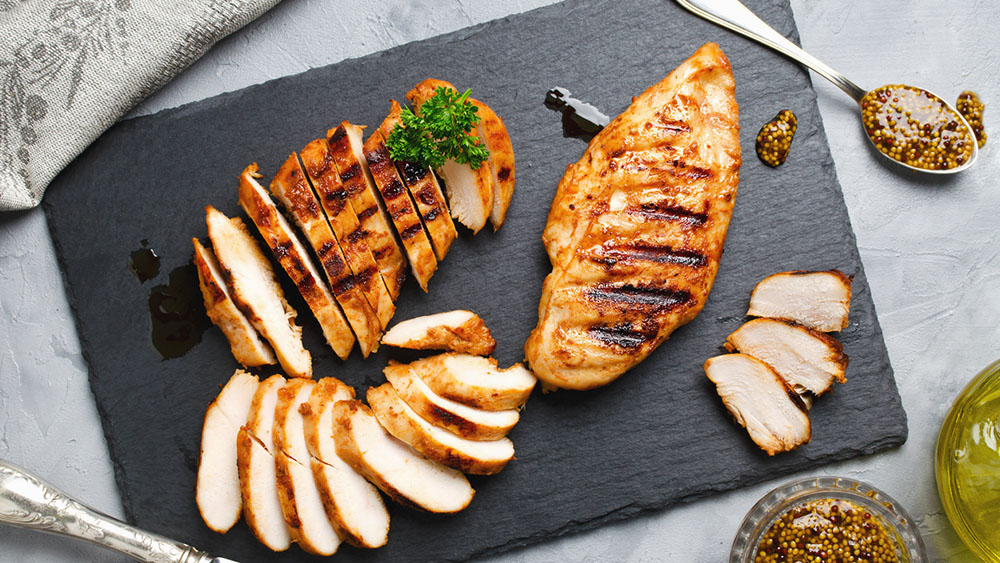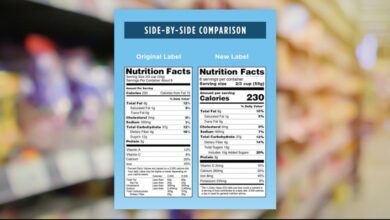
How eating red meat or white meat affects your cholesterol is a crucial question for anyone concerned about their heart health. This exploration dives deep into the impact of different meats on cholesterol levels, examining the nuances of various cuts and cooking methods. We’ll uncover the science behind how red meat and white meat affect LDL and HDL cholesterol, providing a comprehensive understanding to guide you towards informed dietary choices.
From understanding the basics of cholesterol and its impact on the body to comparing the cholesterol content of various red and white meats, this guide provides detailed insights. Tables showcasing the cholesterol content and types of fat in different meats will clarify the nutritional differences and help you make healthier food choices.
Introduction to Cholesterol and Diet

Cholesterol is a waxy, fat-like substance crucial for various bodily functions, including hormone production and cell structure. While essential, an imbalance in cholesterol levels can contribute to health issues. Understanding how diet impacts cholesterol is key to maintaining a healthy lifestyle.Dietary choices significantly affect cholesterol levels. The types and amounts of fats, proteins, and carbohydrates consumed play a critical role in regulating cholesterol production and absorption in the body.
This influence extends beyond the immediate effect on cholesterol numbers; a healthy diet contributes to overall well-being, influencing various aspects of health.
Cholesterol Overview
Cholesterol is carried through the bloodstream by lipoproteins, with low-density lipoproteins (LDL) and high-density lipoproteins (HDL) being the primary types. LDL, often called “bad” cholesterol, can accumulate in arteries, contributing to plaque buildup. HDL, conversely, is often referred to as “good” cholesterol, as it helps remove excess cholesterol from the arteries, thereby protecting against plaque formation.
Dietary Impact on Cholesterol
Dietary modifications can positively or negatively influence cholesterol levels. A diet rich in saturated and trans fats can raise LDL cholesterol, increasing the risk of cardiovascular disease. Conversely, diets rich in soluble fiber, unsaturated fats, and lean proteins can help maintain healthy cholesterol levels.
Dietary Changes and Cholesterol Impact
Different dietary components affect cholesterol levels in various ways. A balanced diet, emphasizing certain foods and minimizing others, can lead to positive changes in cholesterol profile.
| Food Type | Cholesterol Type | Impact |
|---|---|---|
| Saturated Fats (e.g., red meat, full-fat dairy) | LDL | Negative |
| Unsaturated Fats (e.g., avocados, nuts, olive oil) | HDL | Positive |
| Soluble Fiber (e.g., oats, beans, fruits) | LDL | Positive |
| Trans Fats (e.g., processed foods, some fried foods) | LDL | Negative |
| Lean Protein (e.g., fish, poultry without skin) | Neutral to Positive (depending on the specific type and preparation) | Neutral to Positive |
Red Meat and Cholesterol
Red meat, a staple in many diets, has long been a subject of discussion regarding its impact on cholesterol levels. Understanding the potential effects of red meat consumption is crucial for making informed dietary choices. This section delves into the relationship between red meat and cholesterol, exploring various factors like different cuts, saturated fat content, and potential health implications.Red meat, particularly beef, lamb, and pork, contains varying amounts of saturated fat and cholesterol.
The interplay between these components and LDL (“bad”) cholesterol levels is a key consideration for individuals concerned about heart health. Different types of red meat may have different impacts, and understanding these nuances can guide personalized dietary strategies.
Potential Effects on LDL Cholesterol
Red meat, due to its saturated fat content, can contribute to elevated LDL cholesterol levels. This is a significant concern as high LDL cholesterol is a risk factor for cardiovascular disease. However, individual responses vary, influenced by factors such as genetics, overall diet, and lifestyle choices.
Types of Red Meat and Their Potential Impact
Different types of red meat exhibit variations in their fat content and, consequently, their potential impact on cholesterol. Beef, lamb, and pork each have distinct fatty compositions. Lean cuts of red meat often contain less saturated fat and cholesterol compared to fatty cuts. Understanding these differences is key to managing cholesterol levels effectively.
Comparison of Cholesterol Content in Red Meat Cuts
The cholesterol content of red meat varies significantly depending on the cut and preparation method. Fatty cuts, like the sirloin, tend to have higher cholesterol content than leaner cuts, such as the round or loin. Cooking methods, like grilling or frying, can also influence the overall fat content and, thus, the cholesterol level.
Saturated Fat Content and its Relation to Cholesterol
Saturated fat is a major contributor to the potential impact of red meat on cholesterol. Saturated fat is directly associated with elevated LDL cholesterol levels. The higher the saturated fat content, the greater the potential for increased LDL cholesterol.
Comparison Table: Cholesterol Content of Different Red Meat Types
| Meat Type | Approximate Cholesterol Content (per 3-ounce serving, cooked) |
|---|---|
| Beef (Sirloin) | 80-90 mg |
| Beef (Round) | 60-70 mg |
| Lamb (Leg) | 85-95 mg |
| Lamb (Shoulder) | 70-80 mg |
| Pork (Loin) | 65-75 mg |
| Pork (Belly) | 90-100 mg |
Note: Values are approximate and may vary based on specific cuts and preparation methods.
Potential Health Benefits and Drawbacks
Red meat can be a source of essential nutrients like iron and zinc. However, excessive consumption of red meat, particularly fatty cuts, may increase the risk of certain health problems, including heart disease and certain types of cancer. A balanced diet that incorporates a variety of foods, including lean protein sources, is crucial for overall health. Moderation is key when incorporating red meat into a healthy diet.
White Meat and Cholesterol: How Eating Red Meat Or White Meat Affects Your Cholesterol
White meat, a popular choice for many, often gets a mixed reputation regarding its impact on cholesterol levels. Understanding the nuances of different white meat types, their fat content, and how that translates to cholesterol response is crucial for making informed dietary decisions. This section delves into the effects of white meat consumption on cholesterol, examining the variations within white meat categories and their potential health implications.
Impact on Cholesterol Levels
White meat, encompassing chicken, turkey, and fish, generally has a lower saturated fat content compared to red meat. This lower saturated fat content translates to a potential reduction in the elevation of LDL (“bad”) cholesterol, a key factor in heart health. However, the cholesterol impact isn’t uniform across all white meat types, as fat composition and overall dietary context play important roles.
The types of fat present in the meat directly influence its effect on blood lipid profiles.
Comparison of White Meat Types
The cholesterol content and fat composition vary considerably between different white meat sources. Chicken, turkey, and fish each present unique characteristics regarding their impact on cholesterol levels.
Red meat often gets a bad rap when it comes to cholesterol, but surprisingly, white meat can also contribute. While the exact impact varies, it’s worth considering how dietary choices, like meat consumption, might be affecting the health of middle-aged Americans. Recent studies suggest that middle-aged Americans are in worse shape than previous generations middle aged americans worse shape than previous generations , potentially highlighting the need for a more balanced approach to nutrition.
Ultimately, understanding how different proteins affect cholesterol levels is key to making informed choices for a healthier lifestyle.
Cholesterol and Fat Content in White Meat, How eating red meat or white meat affects your cholesterol
- Chicken: Chicken, particularly dark meat, often contains higher levels of saturated fat compared to white meat. The skin is a significant contributor to the saturated fat content. Choosing skinless chicken breast significantly reduces saturated fat intake.
- Turkey: Turkey generally has a lower saturated fat content than chicken. Similar to chicken, the skin contributes more saturated fat. Turkey breast is a healthier choice, offering a leaner protein source.
- Fish: Fish, a diverse category, encompasses a wide range of saturated fat and cholesterol contents. Fatty fish like salmon and tuna contain higher levels of healthy unsaturated fats, which can positively impact cholesterol profiles. Leaner fish varieties have less saturated fat and cholesterol.
Types of Fat and Their Impact
The types of fat present in white meat significantly influence their effect on cholesterol. Saturated fats raise LDL cholesterol levels more than other types of fats. Unsaturated fats, particularly polyunsaturated and monounsaturated fats, can help maintain healthy cholesterol levels. Trans fats are generally considered unhealthy and should be limited in the diet.
Potential Health Benefits and Drawbacks
Consuming white meat, especially lean varieties like fish, can offer several potential health benefits. It’s a good source of protein and essential nutrients. However, excessive consumption of white meat, especially with high-fat cuts, may contribute to elevated cholesterol levels if not part of a balanced diet. The cooking method also influences the fat content and cholesterol impact.
Saturated Fat Content Differences
The saturated fat content varies significantly among white meat types. Chicken and turkey, particularly with skin, contain more saturated fat compared to fish. Lean cuts of white meat, such as skinless chicken breast and various fish varieties, offer lower saturated fat levels.
Ever wondered how red meat or white meat impacts your cholesterol levels? While the specifics can be complex, a healthy gut plays a crucial role in regulating cholesterol. Did you know that a healthy gut microbiome can actually influence how your body processes dietary fats, impacting cholesterol levels? For example, check out how a healthy gut affects heart health in this article: 3 ways healthy gut impacts heart health.
Ultimately, understanding how your gut interacts with your diet is key to managing cholesterol levels, whether you’re aiming for a leaner red meat intake or a balanced white meat consumption.
Comparison Table
| Meat Type | Cholesterol Content (mg/3oz cooked) | Saturated Fat (g/3oz cooked) |
|---|---|---|
| Skinless Chicken Breast | 70-80 | 0.5-1 |
| Chicken with Skin | 90-100 | 1.5-2 |
| Turkey Breast | 80-90 | 0.8-1.2 |
| Turkey with Skin | 95-105 | 2-2.5 |
| Salmon | 60-70 | 1-1.5 |
| Tuna | 30-40 | 0.5-0.8 |
Comparing Red Meat and White Meat Effects
Red meat and white meat are both popular protein sources, but their effects on cholesterol levels differ. Understanding these nuances is crucial for anyone looking to manage their cholesterol and maintain a healthy diet. This comparison delves into the cholesterol-raising potential of each type, the impact of cooking methods, and practical strategies for incorporating them into a healthy eating plan.Comparing the cholesterol-raising potential of red meat and white meat requires a nuanced approach.
While both can impact cholesterol levels, the type and preparation of the meat play a critical role. The differences are subtle, but they can be significant when considering overall dietary strategies for managing cholesterol.
Impact of Cooking Methods
Different cooking methods can affect the cholesterol content and overall nutritional profile of both red and white meats. How the meat is prepared significantly impacts its fat content and, consequently, its potential impact on cholesterol levels. For example, frying meat in oil often results in higher fat absorption compared to grilling or baking.
| Meat Type | Cooking Method | Impact on Cholesterol |
|---|---|---|
| Red Meat | Frying | Higher fat absorption, potentially leading to increased cholesterol levels. |
| Red Meat | Grilling | Lower fat absorption than frying, potentially a slightly lower cholesterol impact. |
| Red Meat | Baking | Lowest fat absorption among the methods listed, generally the most favorable for managing cholesterol. |
| White Meat | Frying | Similar fat absorption to red meat when fried, potentially increasing cholesterol levels. |
| White Meat | Grilling | Lower fat absorption than frying, a slightly lower cholesterol impact compared to frying. |
| White Meat | Baking | Lowest fat absorption among the methods listed, generally the most favorable for managing cholesterol. |
Dietary Strategies for Managing Cholesterol
Maintaining healthy cholesterol levels while enjoying meat requires careful consideration of portion sizes and cooking methods. Balancing your diet with lean proteins, fruits, vegetables, and whole grains can contribute to overall cholesterol management.
- Portion Control: Reducing portion sizes of both red and white meats can help limit the overall intake of saturated fat and cholesterol. Focus on appropriate serving sizes based on individual dietary needs and guidelines.
- Healthy Fats: Incorporating healthy fats, such as those found in avocados, nuts, and olive oil, can support heart health and help balance cholesterol levels.
- Fiber-Rich Foods: Consuming foods rich in fiber, such as fruits, vegetables, and whole grains, can aid in cholesterol reduction by binding to cholesterol in the digestive tract and promoting its excretion.
Healthy Meal Options
Integrating both red and white meat into a balanced diet is possible. Here are a few examples of meals that incorporate both types of meat in a healthy way:
- Grilled Chicken Salad with Lean Beef: Grilled chicken breast paired with a mixed green salad, topped with lean ground beef and a light vinaigrette dressing. This offers lean protein from both types of meat while keeping the fat content relatively low.
- Baked Pork Tenderloin with Roasted Vegetables and Salmon: A baked pork tenderloin served alongside roasted vegetables (such as broccoli, carrots, and sweet potatoes) and a portion of baked salmon. This showcases lean protein options and emphasizes the importance of vegetables in a balanced meal.
Portion Size
Portion sizes play a vital role in managing cholesterol levels when consuming any type of meat. Eating appropriate portions helps to regulate the intake of saturated fat and cholesterol. Consider consulting with a registered dietitian or nutritionist for personalized recommendations on portion sizes based on your specific dietary needs and goals.
Dietary Recommendations for Cholesterol Management

Managing cholesterol levels through diet is crucial for overall health. A balanced approach that considers the types and portions of red and white meat, along with other dietary components, plays a vital role in achieving healthy cholesterol levels. This involves understanding the impact of different food groups and adopting strategies for incorporating them into a nutritious diet.
Incorporating Red and White Meat into a Healthy Diet
A balanced diet, when it comes to meat consumption, includes both red and white meat in moderation. Prioritizing lean cuts of both types is essential. For red meat, this might involve opting for sirloin or flank steak over rib-eye. Likewise, choosing chicken breast or turkey breast over darker meat portions is beneficial for white meat. This focus on leaner cuts helps minimize the intake of saturated fats, which can negatively impact cholesterol levels.
Balancing Meat Consumption with Other Food Groups
Successfully managing cholesterol necessitates a holistic approach to nutrition. Simply reducing meat consumption isn’t sufficient; a balanced diet should include fruits, vegetables, and whole grains. These components provide essential vitamins, minerals, and fiber, which aid in cholesterol regulation. The ratio of meat to other food groups is critical; a healthy diet will include substantial portions of fruits, vegetables, and whole grains alongside meat.
Role of Other Dietary Components in Cholesterol Management
Fruits, vegetables, and fiber play crucial roles in cholesterol management. Fruits and vegetables are excellent sources of soluble fiber, which helps lower LDL (“bad”) cholesterol levels. Whole grains, legumes, and certain fruits are rich in soluble fiber. Incorporating these foods into daily meals can significantly improve cholesterol profiles.
While researching how red meat and white meat impact cholesterol levels, I stumbled upon some fascinating insights into toddler sleep. It got me thinking about how different foods affect our bodies, and the crucial role nutrition plays in overall well-being. Finding the right products to help toddlers sleep can be tricky, but it’s important to consider the balance of nutrients in their diets.
Ultimately, understanding the cholesterol-raising potential of red meat and white meat is vital for making informed food choices for both adults and children. This knowledge helps in making balanced dietary decisions, ensuring both adults and children are nourished correctly. Products to help toddlers sleep can be a game-changer for parents, and I think there are many parallels to making healthy food choices for our children.
Importance of Consulting a Healthcare Professional
Individual dietary needs vary. While general guidelines can be helpful, consulting a healthcare professional or registered dietitian is crucial for personalized dietary advice. Factors such as pre-existing health conditions, specific dietary restrictions, and individual metabolic responses to food need to be considered for optimal cholesterol management.
Examples of Balanced Meals Incorporating Red or White Meat
Here are examples of meals incorporating red or white meat, emphasizing a balanced approach:
- Lean Beef and Veggie Stir-fry: Lean beef sirloin stir-fried with broccoli, carrots, bell peppers, and brown rice. This meal provides protein from lean meat, fiber from vegetables, and complex carbohydrates from brown rice.
- Grilled Chicken Salad: Grilled chicken breast served over a mixed greens salad with avocado, tomatoes, and a light vinaigrette dressing. This meal offers protein, healthy fats, and essential nutrients from vegetables.
- Turkey Meatloaf with Roasted Root Vegetables: Turkey meatloaf served with roasted sweet potatoes, carrots, and parsnips. This combination offers lean protein, fiber, and vitamins.
Healthy Dietary Recommendations for Managing Cholesterol
| Food Group | Specific Recommendations |
|---|---|
| Red Meat | Choose lean cuts, limit portions, and consume in moderation. |
| White Meat | Prioritize lean cuts, like chicken breast, and limit consumption of fatty portions. |
| Fruits and Vegetables | Incorporate a wide variety into daily meals, emphasizing those rich in soluble fiber. |
| Whole Grains | Include brown rice, quinoa, and whole-wheat bread in your diet. |
| Healthy Fats | Include avocados, nuts, and olive oil in moderation. |
| Fiber-Rich Foods | Consume plenty of beans, lentils, and fruits to support cholesterol management. |
| Dairy Products | Choose low-fat or fat-free options when possible. |
Illustrative Dietary Examples
Understanding how to incorporate lean protein sources into a balanced diet is crucial for managing cholesterol levels effectively. This section provides practical examples of healthy meal plans featuring both red and white meat, demonstrating how to maintain a nutritious diet while addressing your cholesterol concerns. These meal plans are designed to be flexible and adaptable to individual needs and preferences.
Healthy Meal Plan Incorporating Red Meat
This meal plan incorporates lean red meat, emphasizing the importance of portion control and pairing it with nutrient-rich vegetables and whole grains. It prioritizes balanced nutrition and focuses on moderation to support overall health.
- Breakfast: A 3-ounce portion of grilled lean beef sirloin, a side of whole-wheat toast with avocado, and a glass of unsweetened almond milk. The beef sirloin is a great source of high-quality protein. Whole-wheat toast provides complex carbohydrates for sustained energy, while avocado offers healthy fats and fiber. Almond milk provides calcium and vitamin E.
- Lunch: A 4-ounce portion of lean ground beef stir-fry with mixed vegetables (broccoli, carrots, bell peppers). This dish is served with brown rice. Ground beef, leaner cuts, are a good source of protein and iron. The stir-fry vegetables contribute essential vitamins, minerals, and fiber, while brown rice provides complex carbohydrates.
- Dinner: A 5-ounce portion of baked lean pork tenderloin with roasted asparagus and sweet potatoes. Baked pork tenderloin, leaner cuts, is a great source of protein. Roasted asparagus and sweet potatoes provide vitamins, minerals, and fiber.
Healthy Meal Plan Incorporating White Meat
This meal plan showcases the nutritional value of white meat, focusing on lean cuts and pairing them with fruits, vegetables, and healthy fats.
- Breakfast: A 4-ounce portion of grilled chicken breast, a side of oatmeal with berries, and a cup of Greek yogurt. Chicken breast is a lean source of protein. Oatmeal provides fiber and complex carbohydrates, berries offer vitamins and antioxidants, and Greek yogurt offers protein and calcium.
- Lunch: A 5-ounce portion of grilled turkey breast salad with mixed greens, cucumber, tomato, and a light vinaigrette dressing. Turkey breast, leaner cuts, is a good source of protein. The salad provides essential vitamins, minerals, and fiber. The vinaigrette dressing adds healthy fats.
- Dinner: A 6-ounce portion of baked cod with steamed green beans and quinoa. Baked cod is a great source of protein. Steamed green beans and quinoa provide vitamins, minerals, and fiber.
Incorporating Lean Protein Sources into a Balanced Diet
A balanced diet incorporates lean protein sources in appropriate portions to support overall health and manage cholesterol levels.
- Variety is Key: Incorporating various lean protein sources ensures a wider range of nutrients. Chicken, turkey, fish, beans, lentils, and tofu are examples of lean protein sources.
- Portion Control: Pay attention to portion sizes to manage calorie intake. Overeating lean protein can still contribute to weight gain if consumed in excess.
- Pair with Nutritious Foods: Pair lean protein sources with plenty of fruits, vegetables, and whole grains to create balanced meals.
Detailed Explanation of Ingredients
This section provides details about the nutritional content of the ingredients mentioned in the meal plans. This information can help you make informed choices about your diet.
| Ingredient | Nutritional Content |
|---|---|
| Lean Beef Sirloin | High-quality protein, iron, zinc, B vitamins. |
| Whole-wheat Toast | Complex carbohydrates, fiber, B vitamins. |
| Avocado | Healthy fats, fiber, potassium, vitamin K. |
| Ground Beef (Lean) | Protein, iron, zinc, B vitamins. |
| Mixed Vegetables | Vitamins, minerals, fiber. |
| Brown Rice | Complex carbohydrates, fiber, B vitamins. |
| Pork Tenderloin (Lean) | Protein, iron, zinc, B vitamins. |
| Asparagus | Vitamins, minerals, fiber. |
| Sweet Potatoes | Complex carbohydrates, fiber, vitamin A. |
| Chicken Breast | Protein, niacin, selenium. |
| Oatmeal | Fiber, complex carbohydrates, B vitamins. |
| Greek Yogurt | Protein, calcium, probiotics. |
| Turkey Breast | Protein, niacin, selenium. |
| Mixed Greens | Vitamins, minerals, fiber. |
| Cucumber, Tomato | Water, vitamins, minerals, fiber. |
| Light Vinaigrette Dressing | Healthy fats, vitamins, minerals. |
| Baked Cod | Protein, omega-3 fatty acids, vitamin D. |
| Steamed Green Beans | Vitamins, minerals, fiber. |
| Quinoa | Complete protein, fiber, iron. |
Illustration of a Balanced Meal with White Meat
Imagine a plate showcasing a grilled chicken breast (approximately 4 ounces) resting atop a bed of mixed greens. Colorful chopped vegetables like bell peppers, cucumbers, and cherry tomatoes are scattered around the chicken. A small portion of quinoa (about ½ cup cooked) is placed beside the greens. A light vinaigrette dressing drizzles over the salad. The overall appearance is vibrant and visually appealing, highlighting the balance of protein, vegetables, and grains.
Illustration of a Balanced Meal with Red Meat
Visualize a plate with a lean beef sirloin (approximately 3 ounces) pan-seared to a perfect medium-rare. A generous portion of roasted asparagus and sweet potatoes (about 1 cup each) is arranged alongside the beef. A small portion of whole-wheat toast (about 1 slice) is positioned to the side. The plate evokes a balanced combination of protein, vegetables, and whole grains.
The colors are appealing, reflecting the healthy composition of the meal.
Final Summary
In conclusion, the effect of red and white meat on cholesterol is multifaceted and depends on factors like cut, cooking method, and overall diet. Making informed decisions about meat consumption, combined with a balanced diet rich in fruits, vegetables, and fiber, can significantly influence your cholesterol levels. Consulting a healthcare professional for personalized dietary advice is always recommended for optimal health management.





